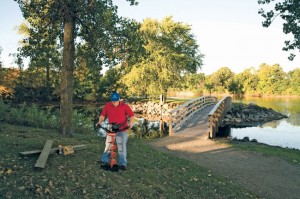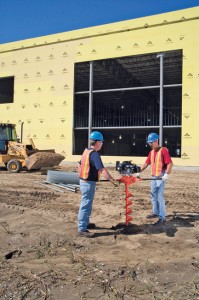Hole Diggers for Dummies. Smart Tips for Simple Hand-Held Earth Auger Operations.
Story: Dennis Von Ruden – Sept. 07 2011
compactequip.com
Jobsites don’t see too many machines simpler than an earth auger. However, manufacturers build them this way because there’s just no reason to make them complex. Even an auger’s purpose is simple. Whether the application is construction, landscaping, fence installation or a homeowner project, earth augers do one thing and one thing only – dig holes.
But while the equipment and its function are not complicated, not everyone will achieve the same level of success with a hole digger. There are some basic operational hints – along with a list of mistakes to avoid – that should be considered in order to ensure safety and maximize productivity on the job.
Ready to Dig?
There’s no sense in getting started until both the equipment and operator are prepared to go to work. Assuming the hole digger itself has been properly maintained and is in good mechanical condition, the first thing the operator should do is examine the auger’s common wear parts, such as the screw bit and teeth.
The screw bit is the very tip of the auger. If it is extremely worn – or perhaps even completely gone – the auger will not track straight as it digs. Augers can dig aggressively when their teeth are in good shape, but if not, the auger flighting must pick up the slack and absorb unnecessary wear. Worn teeth can also decrease digging capacity and force the auger to become stuck in the ground.
Next, take time to read over the operator’s manual. While this task may seem unnecessary to some experienced operators, it’s still an important step – particularly if it’s been a while since the operator has used a hole digger, or if the equipment works a little differently than augers he or she has used in the past. Manufacturers cover just about everything there is to know about safe and efficient operation in their manuals. This information is invaluable for novices, and giving the manual a quick read might even teach an old dog a few new tricks.
After reading the manual, the next step is to identify underground obstructions. Always call an underground locating service before you dig to identify the whereabouts of buried lines. Also, beware of natural obstructions like rocks or tree roots. Grass and other overgrowth can also hamper an auger’s digging ability by clogging the auger blade and screw bit, and therefore should be removed to increase efficiency and overall productivity.
Proper Start-Up
Once all the jobsite parameters have been established, it’s time to get digging. Pay attention to the operating instructions for starting the hole digger’s engine. The machine is designed to keep the operator away from the engine exhaust muffler. With an improper operating position, the operator runs the risk of serious injury from coming into contact with the hot surface of the muffler or from inhaling high levels of carbon monoxide.
Allow the engine to properly warm up to the point where it will operate without the engine choke. Keep in mind that in cold weather, initial starting may require more pulls. Once running, if the hole digger or an individual component or accessory does not appear to be functioning properly, stop immediately and correct the problem before resuming work.
Normal operating procedure for a handheld hole digger is to dig with the engine going at full speed. This allows the unit’s centrifugal clutch to become more firmly engaged, thus transmitting more usable power to the auger. When using a hole digging attachment, proper auger rpm will vary, but generally the operator should feed the auger as fast as soil conditions will allow.
 Kickback, Don’t Relax Position
Kickback, Don’t Relax Position
When working in areas with rocks or other obstructions that could be struck by a handheld auger, an operator should be prepared for the occurrence of kickback force. If kickback is anticipated, the hole digger should be operated at less than full speed to ensure a more rapid release of the centrifugal clutch when an obstruction is encountered.
An operator can minimize the effects of kickback through proper body positioning. Keep the left side of the equipment handle as close as possible to your left hip and leg area. Your upper arms should be kept close to the body to maximize mechanical leverage. Keep your back vertical by bending your legs as needed while digging, and position the left foot ahead of the right foot at a comfortable distance.
Experienced operators who understand kickback sometimes choose to absorb its effects while attempting to use the auger blade to “chip” their way around or through an obstruction. This technique usually involves holding up on the operator handle and establishing a minimum feed rate for the auger. Often the nature and size of a buried object will simply prevent the auger from passing by or going through it, forcing workers to find a more suitable tool to remove it. The main point is that kickback is manageable when proper operating position is maintained, but is equally challenging if the operator is not prepared for it.
Operators would be well advised to wear gloves while running a hole digger and should always keep a firm and steady grip on the handles. This helps to reduce fatigue, as well as increase productivity. If an operator ever realizes that he is in the process of losing full control of the hole digger for any reason, he should push himself free and clear from the handles.
In the Hole
As a general rule, pressing down on the operator handles is not required to initiate or sustain the digging process. In lower density (soft digging) soils, it may be necessary to hold up on the handle to reduce the digging rate of the auger. In higher density (hard digging) soils, an operator might need to press down on the handles to establish acceptable digging rates. Operators should make judgments based on their individual levels of experience to prevent the auger from burying itself in the hole, which is typically the outcome when allowing the auger to feed at an excessive rate.
Occasionally, operators will wind up stopping the engine while the auger rests in a partially or completely dug hole. Only a skilled operator should attempt to restart the engine while the auger remains in the hole. The more accepted procedure is to first remove the unit from the hole, and then return it to the hole with the engine running only at idle speed. One exception for this is during the use of auger extensions.
Extensions are often called upon when standard length augers are insufficient. Using extensions is a vastly superior alternative to feeble attempts of some to force a standard auger to drill down to extreme depths. This error in judgment usually ends with an auger buried in the ground. The mistake is commonly multiplied when operators try to back the auger out with pipe wrenches. When this exercise proves unsuccessful, some try yanking the auger out with a backhoe or skid steer, which almost always results in the auger becoming bent and broken.
Dig No Further
Of course, no amount of operational advice can really substitute for actual experience. Hole digging professionals develop a natural feel for their craft over time. But new equipment innovations are constantly hitting the market, which means it’s always a good idea to pursue the manual or call the manufacturer for operating tips from time to time. With the right combination of experience, common sense and occasional re-education, auger operators can continue to hone their hole-digging skills to get the most out of their equipment on the job.
Dennis Von Ruden is the president of General Equipment Co., based in Owatonna, Minn.
If you have any questions or comments, please feel free to contact us.
Telephone: 800.533.0524 | Email: support@generalequip.com

